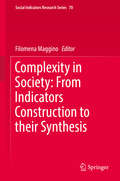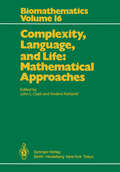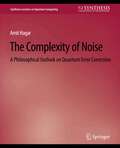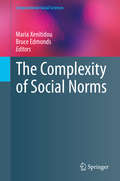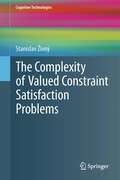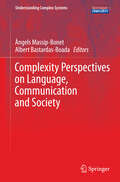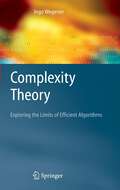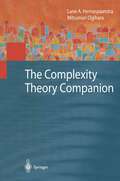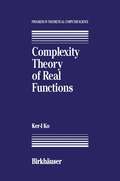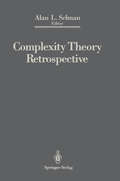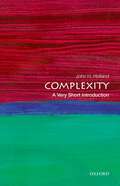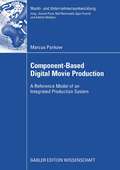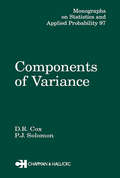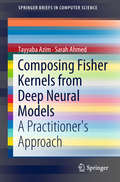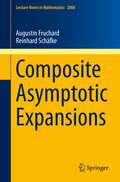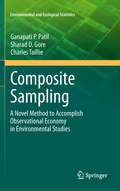- Table View
- List View
Complexity in Landscape Ecology (Landscape Series #4)
by David G. Green Nicholas Klomp Glyn Rimmington Suzanne SadedinInteractions matter. To understand the distributions of plants and animals in a landscape you need to understand how they interact with each other, and with their environment. The resulting networks of interactions make ecosystems highly complex. Recent research on complexity and artificial life provides many new insights about patterns and processes in landscapes and ecosystems. This book provides the first overview of that work for general readers. It covers such topics as connectivity, criticality, feedback, and networks, as well as their impact on the stability and predictability of ecosystem dynamics. With over 60 years of research experience of both ecology and complexity, the authors are uniquely qualified to provide a new perspective on traditional ecology. They argue that understanding ecological complexity is crucial in today’s globalized and interconnected world. Successful management of the world's ecosystems needs to combine models of ecosystem complexity with biodiversity, environmental, geographic and socioeconomic information.
Complexity in Society: From Indicators Construction to their Synthesis (Social Indicators Research Series #70)
by Filomena MagginoThis volume discusses the many recent significant developments, and identifies important problems, in the field of social indicators. In the last ten years the methodology of multivariate analysis and synthetic indicators construction significantly developed. In particular, starting from the classical theory of composite indicators many interesting approaches have been developed to overcome the weaknesses of composites. This volume focuses on these recent developments in synthesizing indicators, and more generally, in quantifying complex phenomena.
Complexity, Language, and Life: Mathematical Approaches (Biomathematics #16)
by John L. Casti Anders KarlqvistIn May 1984 the Swedish Council for Scientific Research convened a small group of investigators at the scientific research station at Abisko, Sweden, for the purpose of examining various conceptual and mathematical views of the evolution of complex systems. The stated theme of the meeting was deliberately kept vague, with only the purpose of discussing alternative mathematically based approaches to the modeling of evolving processes being given as a guideline to the participants. In order to limit the scope to some degree, it was decided to emphasize living rather than nonliving processes and to invite participants from a range of disciplinary specialities spanning the spectrum from pure and applied mathematics to geography and analytic philosophy. The results of the meeting were quite extraordinary; while there was no intent to focus the papers and discussion into predefined channels, an immediate self-organizing effect took place and the deliberations quickly oriented themselves into three main streams: conceptual and formal structures for characterizing sys tem complexity; evolutionary processes in biology and ecology; the emergence of complexity through evolution in natural lan guages. The chapters presented in this volume are not the proceed ings of the meeting. Following the meeting, the organizers felt that the ideas and spirit of the gathering should be preserved in some written form, so the participants were each requested to produce a chapter, explicating the views they presented at Abisko, written specifically for this volume. The results of this exercise form the volume you hold in your hand.
The Complexity of Noise: A Philosophical Outlook on Quantum Error Correction (Synthesis Lectures on Quantum Computing)
by Amit HagarIn quantum computing, where algorithms exist that can solve computational problems more efficiently than any known classical algorithms, the elimination of errors that result from external disturbances or from imperfect gates has become the "holy grail", and a worldwide quest for a large scale fault-tolerant, and computationally superior, quantum computer is currently taking place. Optimists rely on the premise that, under a certain threshold of errors, an arbitrary long fault-tolerant quantum computation can be achieved with only moderate (i.e., at most polynomial) overhead in computational cost. Pessimists, on the other hand, object that there are in principle (as opposed to merely technological) reasons why such machines are still inexistent, and that no matter what gadgets are used, large scale quantum computers will never be computationally superior to classical ones. Lacking a complete empirical characterization of quantum noise, the debate on the physical possibility of such machines invites philosophical scrutiny. Making this debate more precise by suggesting a novel statistical mechanical perspective thereof is the goal of this project. Table of Contents: Introduction / The Curse of the Open System / To Balance a Pencil on Its Tip / Universality at All Cost / Coda
The Complexity of Social Norms (Computational Social Sciences)
by Maria Xenitidou Bruce EdmondsThis book explores the view that normative behaviour is part of a complex of social mechanisms, processes and narratives that are constantly shifting. From this perspective, norms are not a kind of self-contained social object or fact, but rather an interplay of many things that we label as norms when we ‘take a snapshot’ of them at a particular instant. Further, this book pursues the hypothesis that considering the dynamic aspects of these phenomena sheds new light on them.The sort of issues that this perspective opens to exploration include:Of what is this complex we call a "social norm" composed of?How do new social norms emerge and what kind of circumstances might facilitate such an appearance?How context-specific are the norms and patterns of normative behaviour that arise?How do the cognitive and the social aspects of norms interact over time?How do expectations, beliefs and individual rationality interact with social norm complexes to effect behaviour?How does our social embeddedness relate to social constraint upon behaviour?How might the socio-cognitive complexes that we call norms be usefully researched?
The Complexity of Valued Constraint Satisfaction Problems (Cognitive Technologies)
by Stanislav ŽivnýThe topic of this book is the following optimisation problem: given a set of discrete variables and a set of functions, each depending on a subset of the variables, minimise the sum of the functions over all variables. This fundamental research problem has been studied within several different contexts of discrete mathematics, computer science and artificial intelligence under different names: Min-Sum problems, MAP inference in Markov random fields (MRFs) and conditional random fields (CRFs), Gibbs energy minimisation, valued constraint satisfaction problems (VCSPs), and, for two-state variables, pseudo-Boolean optimisation.In this book the author presents general techniques for analysing the structure of such functions and the computational complexity of the minimisation problem, and he gives a comprehensive list of tractable cases. Moreover, he demonstrates that the so-called algebraic approach to VCSPs can be used not only for the search for tractable VCSPs, but also for other questions such as finding the boundaries to the applicability of certain algorithmic techniques.The book is suitable for researchers interested in methods and results from the area of constraint programming and discrete optimisation.
Complexity Perspectives on Language, Communication and Society (Understanding Complex Systems)
by Àngels Massip-Bonet Albert Bastardas-BoadaThe “language-communication-society” triangle defies traditional scientific approaches. Rather, it is a phenomenon that calls for an integration of complex, transdisciplinary perspectives, if we are to make any progress in understanding how it works. The highly diverse agents in play are not merely cognitive and/or cultural, but also emotional and behavioural in their specificity. Indeed, the effort may require building a theoretical and methodological body of knowledge that can effectively convey the characteristic properties of phenomena in human terms.New complexity approaches allow us to rethink our limited and mechanistic images of human societies and create more appropriate emo-cognitive dynamic and holistic models. We have to enter into dialogue with the complexity views coming out of other more ‘material’ sciences, but we also need to take steps in the linguistic and psycho-sociological fields towards creating perspectives and concepts better fitted to human characteristics.Our understanding of complexity is different – but not opposed – to the one that is more commonly found in texts written by people working in physics or computer science, for example. The goal of this book is to extend the knowledge of these other more ‘human’ or socially oriented perspectives on complexity, taking account of the language and communication singularities of human agents in society. Our understanding of complexity is different – but not opposed – to the one that is more commonly found in texts written by people working in physics or computer science, for example. The goal of this book is to extend the knowledge of these other more ‘human’ or socially oriented perspectives on complexity, taking account of the language and communication singularities of human agents in society.
Complexity Theory: Exploring the Limits of Efficient Algorithms
by Ingo WegenerReflects recent developments in its emphasis on randomized and approximation algorithms and communication models All topics are considered from an algorithmic point of view stressing the implications for algorithm design
The Complexity Theory Companion (Texts in Theoretical Computer Science. An EATCS Series)
by Lane A. Hemaspaandra Mitsunori OgiharaHere is an accessible, algorithmically oriented guide to some of the most interesting techniques of complexity theory. The book shows that simple algorithms are at the heart of complexity theory. The book is organized by technique rather than by topic. Each chapter focuses on one technique: what it is, and what results and applications it yields.
Complexity Theory of Real Functions (Progress in Theoretical Computer Science)
by K. KoStarting with Cook's pioneering work on NP-completeness in 1970, polynomial complexity theory, the study of polynomial-time com putability, has quickly emerged as the new foundation of algorithms. On the one hand, it bridges the gap between the abstract approach of recursive function theory and the concrete approach of analysis of algorithms. It extends the notions and tools of the theory of computability to provide a solid theoretical foundation for the study of computational complexity of practical problems. In addition, the theoretical studies of the notion of polynomial-time tractability some times also yield interesting new practical algorithms. A typical exam ple is the application of the ellipsoid algorithm to combinatorial op timization problems (see, for example, Lovasz [1986]). On the other hand, it has a strong influence on many different branches of mathe matics, including combinatorial optimization, graph theory, number theory and cryptography. As a consequence, many researchers have begun to re-examine various branches of classical mathematics from the complexity point of view. For a given nonconstructive existence theorem in classical mathematics, one would like to find a construc tive proof which admits a polynomial-time algorithm for the solution. One of the examples is the recent work on algorithmic theory of per mutation groups. In the area of numerical computation, there are also two tradi tionally independent approaches: recursive analysis and numerical analysis.
Complexity Theory Retrospective: In Honor of Juris Hartmanis on the Occasion of His Sixtieth Birthday, July 5, 1988
by Alan L. SelmanIn 1965 Juris Hartmanis and Richard E. Stearns published a paper "On the Computational Complexity of Algorithms". The field of complexity theory takes its name from this seminal paper and many of the major concepts and issues of complexity theory were introduced by Hartmanis in subsequent work. In honor of the contribution of Juris Hartmanis to the field of complexity theory, a special session of invited talks by Richard E. Stearns, Allan Borodin and Paul Young was held at the third annual meeting of the Structure in Complexity conference, and the first three chapters of this book are the final versions of these talks. They recall intellectual and professional trends in Hartmanis' contributions. All but one of the remainder of the chapters in this volume originated as a presentation at one of the recent meetings of the Structure in Complexity Theory Conference and appeared in preliminary form in the conference proceedings. In all, these expositions form an excellent description of much of contemporary complexity theory.
Complexity Thinking and China’s Demography Within and Beyond Mainland China: A Geopolitical Overview
by Armando AliuThis book uses complexity thinking to explore China’s demography and population-driven geopolitics within and beyond mainland China. From a multidisciplinary perspective, the book is relevant to the debates of Chinese demography studies and politics of contemporary China. It combines international relations approaches, demography research, and legal studies to conceive the recent demographic trends and social transformations in China and across the world. The book prioritizes the anthropological viewpoint to provide a better understanding of demographic phenomena and combine an anthropological demography perspective with complexity thinking and geopolitics. This book will interest scholars of China, of geopolitics, and demographers.
Complexity: A Very Short Introduction (Very Short Introductions)
by John H. HollandThe importance of complexity is well-captured by Hawking's comment: "Complexity is the science of the 21st century". From the movement of flocks of birds to the Internet, environmental sustainability, and market regulation, the study and understanding of complex non-linear systems has become highly influential over the last 30 years. In this Very Short Introduction, one of the leading figures in the field, John Holland, introduces the key elements and conceptual framework of complexity. From complex physical systems such as fluid flow and the difficulties of predicting weather, to complex adaptive systems such as the highly diverse and interdependent ecosystems of rainforests, he combines simple, well-known examples — Adam Smith's pin factory, Darwin's comet orchid, and Simon's 'watchmaker' — with an account of the approaches, involving agents and urn models, taken by complexity theory. ABOUT THE SERIES: The Very Short Introductions series from Oxford University Press contains hundreds of titles in almost every subject area. These pocket-sized books are the perfect way to get ahead in a new subject quickly. Our expert authors combine facts, analysis, perspective, new ideas, and enthusiasm to make interesting and challenging topics highly readable.
Component-based Digital Movie Production: Reference Model of an Integrated Production System (Markt- und Unternehmensentwicklung Markets and Organisations)
by Marcus PankowMarcus Pankow examines the specifics of the movie production industry and its value-creating processes, reflecting the digitization and its impact on the information systems strategy. Following the concept of a Service Oriented Architecture (SOA), he encapsulates established applications in services and integrates them on one platform.
Components of Variance (Chapman & Hall/CRC Monographs on Statistics and Applied Probability)
by D. R. CoxIdentifying the sources and measuring the impact of haphazard variations are important in any number of research applications, from clinical trials and genetics to industrial design and psychometric testing. Only in very simple situations can such variations be represented effectively by independent, identically distributed random variables or by r
Composing Fisher Kernels from Deep Neural Models: A Practitioner's Approach (SpringerBriefs in Computer Science)
by Tayyaba Azim Sarah AhmedThis book shows machine learning enthusiasts and practitioners how to get the best of both worlds by deriving Fisher kernels from deep learning models. In addition, the book shares insight on how to store and retrieve large-dimensional Fisher vectors using feature selection and compression techniques. Feature selection and feature compression are two of the most popular off-the-shelf methods for reducing data’s high-dimensional memory footprint and thus making it suitable for large-scale visual retrieval and classification. Kernel methods long remained the de facto standard for solving large-scale object classification tasks using low-level features, until the revival of deep models in 2006. Later, they made a comeback with improved Fisher vectors in 2010. However, their supremacy was always challenged by various versions of deep models, now considered to be the state of the art for solving various machine learning and computer vision tasks. Although the two research paradigms differ significantly, the excellent performance of Fisher kernels on the Image Net large-scale object classification dataset has caught the attention of numerous kernel practitioners, and many have drawn parallels between the two frameworks for improving the empirical performance on benchmark classification tasks. Exploring concrete examples on different data sets, the book compares the computational and statistical aspects of different dimensionality reduction approaches and identifies metrics to show which approach is superior to the other for Fisher vector encodings. It also provides references to some of the most useful resources that could provide practitioners and machine learning enthusiasts a quick start for learning and implementing a variety of deep learning models and kernel functions.
Composite Asymptotic Expansions (Lecture Notes in Mathematics #2066)
by Augustin Fruchard Reinhard SchafkeThe purpose of these lecture notes is to develop a theory of asymptotic expansions for functions involving two variables, while at the same time using functions involving one variable and functions of the quotient of these two variables. Such composite asymptotic expansions (CAsEs) are particularly well-suited to describing solutions of singularly perturbed ordinary differential equations near turning points. CAsEs imply inner and outer expansions near turning points. Thus our approach is closely related to the method of matched asymptotic expansions. CAsEs offer two unique advantages, however. First, they provide uniform expansions near a turning point and away from it. Second, a Gevrey version of CAsEs is available and detailed in the lecture notes. Three problems are presented in which CAsEs are useful. The first application concerns canard solutions near a multiple turning point. The second application concerns so-called non-smooth or angular canard solutions. Finally an Ackerberg-O’Malley resonance problem is solved.
Composite Media and Homogenization Theory: An International Centre for Theoretical Physics Workshop Trieste, Italy, January 1990 (Progress in Nonlinear Differential Equations and Their Applications #5)
by Gianfausto Dell'Antonio Gianni Dal MasoComposite Sampling: A Novel Method to Accomplish Observational Economy in Environmental Studies (Environmental and Ecological Statistics #4)
by Ganapati P. Patil Sharad D. Gore Charles TaillieSampling consists of selection, acquisition, and quantification of a part of the population. While selection and acquisition apply to physical sampling units of the population, quantification pertains only to the variable of interest, which is a particular characteristic of the sampling units. A sampling procedure is expected to provide a sample that is representative with respect to some specified criteria. Composite sampling, under idealized conditions, incurs no loss of information for estimating the population means. But an important limitation to the method has been the loss of information on individual sample values, such as, the extremely large value. In many of the situations where individual sample values are of interest or concern, composite sampling methods can be suitably modified to retrieve the information on individual sample values that may be lost due to compositing. This book presents statistical solutions to issues that arise in the context of applications of composite sampling.
Composition Methods in Homotopy Groups of Spheres. (AM-49), Volume 49 (PDF)
by Hiroshi TodaThe description for this book, Composition Methods in Homotopy Groups of Spheres. (AM-49), Volume 49, will be forthcoming.
Composition Operators: and Classical Function Theory (Universitext)
by Joel H. ShapiroThe study of composition operators links some of the most basic questions you can ask about linear operators with beautiful classical results from analytic-function theory. The process invests old theorems with new mean ings, and bestows upon functional analysis an intriguing class of concrete linear operators. Best of all, the subject can be appreciated by anyone with an interest in function theory or functional analysis, and a background roughly equivalent to the following twelve chapters of Rudin's textbook Real and Complex Analysis [Rdn '87]: Chapters 1-7 (measure and integra tion, LP spaces, basic Hilbert and Banach space theory), and 10-14 (basic function theory through the Riemann Mapping Theorem). In this book I introduce the reader to both the theory of composition operators, and the classical results that form its infrastructure. I develop the subject in a way that emphasizes its geometric content, staying as much as possible within the prerequisites set out in the twelve fundamental chapters of Rudin's book. Although much of the material on operators is quite recent, this book is not intended to be an exhaustive survey. It is, quite simply, an invitation to join in the fun. The story goes something like this.
Composition Operators on Spaces of Analytic Functions (Studies In Advanced Mathematics Ser.)
by Carl C. Cowen Jr.The study of composition operators lies at the interface of analytic function theory and operator theory. Composition Operators on Spaces of Analytic Functions synthesizes the achievements of the past 25 years and brings into focus the broad outlines of the developing theory. It provides a comprehensive introduction to the linear operators of composition with a fixed function acting on a space of analytic functions. This new book both highlights the unifying ideas behind the major theorems and contrasts the differences between results for related spaces. Nine chapters introduce the main analytic techniques needed, Carleson measure and other integral estimates, linear fractional models, and kernel function techniques, and demonstrate their application to problems of boundedness, compactness, spectra, normality, and so on, of composition operators. Intended as a graduate-level textbook, the prerequisites are minimal. Numerous exercises illustrate and extend the theory. For students and non-students alike, the exercises are an integral part of the book. By including the theory for both one and several variables, historical notes, and a comprehensive bibliography, the book leaves the reader well grounded for future research on composition operators and related areas in operator or function theory.
Composition Operators on Spaces of Analytic Functions (Studies In Advanced Mathematics Ser.)
by Carl C. Cowen Jr.The study of composition operators lies at the interface of analytic function theory and operator theory. Composition Operators on Spaces of Analytic Functions synthesizes the achievements of the past 25 years and brings into focus the broad outlines of the developing theory. It provides a comprehensive introduction to the linear operators of composition with a fixed function acting on a space of analytic functions. This new book both highlights the unifying ideas behind the major theorems and contrasts the differences between results for related spaces. Nine chapters introduce the main analytic techniques needed, Carleson measure and other integral estimates, linear fractional models, and kernel function techniques, and demonstrate their application to problems of boundedness, compactness, spectra, normality, and so on, of composition operators. Intended as a graduate-level textbook, the prerequisites are minimal. Numerous exercises illustrate and extend the theory. For students and non-students alike, the exercises are an integral part of the book. By including the theory for both one and several variables, historical notes, and a comprehensive bibliography, the book leaves the reader well grounded for future research on composition operators and related areas in operator or function theory.
Compositional Data Analysis: CoDaWork, L’Escala, Spain, June 2015 (Springer Proceedings in Mathematics & Statistics #187)
by Josep Antoni Martín-Fernández Santiago Thió-HenestrosaThe authoritative contributions gathered in this volume reflect the state of the art in compositional data analysis (CoDa). The respective chapters cover all aspects of CoDa, ranging from mathematical theory, statistical methods and techniques to its broad range of applications in geochemistry, the life sciences and other disciplines. The selected and peer-reviewed papers were originally presented at the 6th International Workshop on Compositional Data Analysis, CoDaWork 2015, held in L’Escala (Girona), Spain.Compositional data is defined as vectors of positive components and constant sum, and, more generally, all those vectors representing parts of a whole which only carry relative information. Examples of compositional data can be found in many different fields such as geology, chemistry, economics, medicine, ecology and sociology. As most of the classical statistical techniques are incoherent on compositions, in the 1980s John Aitchison proposed the log-ratio approach to CoDa. This became the foundation of modern CoDa, which is now based on a specific geometric structure for the simplex, an appropriate representation of the sample space of compositional data. The International Workshops on Compositional Data Analysis offer a vital discussion forum for researchers and practitioners concerned with the statistical treatment and modelling of compositional data or other constrained data sets and the interpretation of models and their applications. The goal of the workshops is to summarize and share recent developments, and to identify important lines of future research.
Compositional Data Analysis: Theory and Applications (Statistics In Practice Ser.)
by Vera Pawlowsky-Glahn Antonella BucciantiIt is difficult to imagine that the statistical analysis of compositional data has been a major issue of concern for more than 100 years. It is even more difficult to realize that so many statisticians and users of statistics are unaware of the particular problems affecting compositional data, as well as their solutions. The issue of ``spurious correlation'', as the situation was phrased by Karl Pearson back in 1897, affects all data that measures parts of some whole, such as percentages, proportions, ppm and ppb. Such measurements are present in all fields of science, ranging from geology, biology, environmental sciences, forensic sciences, medicine and hydrology. This book presents the history and development of compositional data analysis along with Aitchison's log-ratio approach. Compositional Data Analysis describes the state of the art both in theoretical fields as well as applications in the different fields of science. Key Features: Reflects the state-of-the-art in compositional data analysis. Gives an overview of the historical development of compositional data analysis, as well as basic concepts and procedures. Looks at advances in algebra and calculus on the simplex. Presents applications in different fields of science, including, genomics, ecology, biology, geochemistry, planetology, chemistry and economics. Explores connections to correspondence analysis and the Dirichlet distribution. Presents a summary of three available software packages for compositional data analysis. Supported by an accompanying website featuring R code. Applied scientists working on compositional data analysis in any field of science, both in academia and professionals will benefit from this book, along with graduate students in any field of science working with compositional data.

